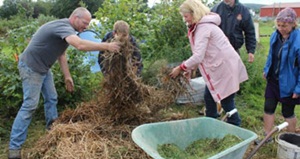
What is permaculture design and what does it bring? Do we need to save the planet? Philippa Robinson from Cultivate tells us what we can learn from the nature and how.

How do we maintain our health, happiness and collective well-being when the world seems to be unravelling? Permaculture is an approach that takes us beyond sustainability to a truly restorative design. Underpinning this is the simple idea of working with, rather than against, nature. …
What do billions of years of resilience have to teach us?
Experience seems to suggest that being on a mission to “save the planet” is actually an unhelpful perspective to taking the action needed to reduce our environmental impact. It’s not the planet that needs saving. As nature is dynamic, always changing, turbulent and unforgiving, any “return to nature” thinking needs to be reframed to look at how we best cope with a rapidly changing world.
As natural systems are resilient, abundant and self-organising, think of what we might learn by observing and emulating them! With nature as a teacher, we could make things in ways that don’t impact the environment and do strengthen our resilience, as well as design systems that will allow our lives and communities to flourish. This is the essence of Permaculture.
In their book, Resilience: Why Things Bounce Back, Andrew Zolli and Ann Marie Healy point out that “a new dialogue is emerging around a new idea, resilience: how to help vulnerable people, organizations and systems persist, perhaps even thrive, amid unforeseeable disruptions. Where sustainability aims to put the world back into balance, resilience looks for ways to manage in an imbalanced world.”
Janine Benyus, an American biologist, coined the term biomimicry for the science of examining the natural world and mimicking it to create more sustainable ways of making and doing things. She describes it as “the conscious emulation of nature’s genius”.
The word is derived from the Greek words bios, meaning life, and mimesis, meaning to imitate.
Architects, engineers and social innovators who use this approach always start with the question: “What would nature do here?” Biomimicry has already helped us to conserve resources, gather water, harvest energy more efficiently, and offers all sorts of innovative responses to the challenges we face.
Biomimicry is well established in the fields of industrial design, engineering and manufacturing, but what I am interested in is how we can use nature as the inspiration for any of us to create solutions for our own and our community’s well-being. We can do this through Permaculture, an “it’s-all-connected” whole systems approach to the way we design our landscapes and human systems.
The essence of Permaculture is the design of an ecologically sound way of living. It is not another “back to nature” movement; it is a very practical and effective way to emulate natural patterns and principles to increase our resilience and quality of life. In the development of a permanent culture, learning by watching what is going on in the natural world is a very powerful tool.
Permaculture is an approach that takes us beyond sustainability to a truly restorative design for creating human habitats and healthy ecosystems. It helps us to protect and enrich soil, boost biodiversity and use natural resources in a healthy way. Underpinning this is the simple idea of working with, rather than against nature.
Permaculture principles can even help us to design viable social systems. The quality of every living system, and its ability to endure, is determined by the quality of its relationships, both internally between its elements and with its environment. This profound lesson from nature can be applied not only to the way we design our gardens and farms but how we structure our organisations and society. Permaculture could be defined as the science of maximising beneficial relationships.
Diversification reduces risk and builds resilience and is essential to a Permaculture approach. Nature relies on a large variety of species, systems and organisms that allow it to withstand external shocks because diversity gives strength. Everyone can study and apply Permaculture design; it really is an application of common sense.
Cultivate are offering a number of Permaculture courses over 2014.
FETAC-accredited courses, held over three weekends, are being hosted in the spring and autumn, and a nine-day, full Permaculture Design Course is held in August.
The courses will be held in the brand new WeCreate Centre in Cloughjordan Ecovillage. This setting provides participants with a unique opportunity to see many key sustainable systems in practice.
For more information on the programme see www.cultivate.ie
Cloughjordan Ecovillage is Ireland’s largest eco-neighbourhood, now home to over 50 families who have relocated in the hope of living a good life. The community have planted thousands of trees, have their own farm and live in efficient eco-houses that are bright and heated by renewable energy.
Source: Cultivate – Permaculture Design – The Fusion of Old Skills and New Technology






